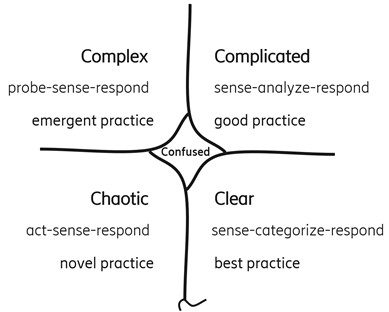This entry was written as part of the Supporting Agile Adoption program, an Agile Alliance initiative dedicated to supporting organizations and their people become more Agile.
We have seen Agile transformations being disrupted by leaders practicing one style of leadership independent of the situation, the people involved, or challenges faced. In our previous article on ‘Support for purpose: Situational awareness for change leaders’. we discussed the importance of being aware of the actual change context. Effective leaders develop active awareness of and are sensitive to, what kind of leadership is required in a specific situation. In this article, we will follow up on the importance of awareness: now that you are aware of your situation and context, what kind of leadership is needed?
Training is Forgotten Over Time
In most organizations, leaders are well educated. They attend leadership trainings that should enable them to lead effectively. Unfortunately, we often see that after the training, over the years, leaders create a preferred personal leadership style and stick to it for many years, regardless of the situation or context. For example, many leaders have gone through leadership programs where they learn about situational leadership. (For example, Ken Blanchard / situational leadership – with the leadership styles of Directing, Coaching, Supporting, and Delegating).
But back in the company, they are often pulled by the traditional organizational behavior into Directing or Delegating styles (typically with a clear definition of responsibilities and accountabilities) which is typically dominant in non-Agile companies. They get positive resonance in this style (since they do what is expected) and thus not only keep that approach for many years, but also lose sight of what benefits other approaches might offer.
Training Your Leadership Muscle
Professionals in leadership positions find themselves on a constant journey to train their leadership ‘muscle’. The problem is if you always do the same exercise, you always train the same muscle. But in our complex modern world, the need for more Agility drives a need to discover and train other ‘leadership muscles’ as well.
‘Agile leadership’ in the literal sense means a leader who is flexible, adaptive, responsive, and nimble, and who is aware of the dynamics of the business and organizational environment in which they lead. In this context, what is needed is a leader who is aware of their own psychology, their impact on people and the organization in various situations, and the correlation between these (aka situational leadership). This requires the willingness to stay alert and keep learning continuously about how to best adapt one’s leadership style.
A good practice is to reflect—ideally with the help from others–on one’s leadership style regularly, generating insights into what is helping and what is not, and then experimenting with adjustments accordingly (and/or learning new leadership styles).

Hopscotching from One Extreme to Another
In a typical journey toward organizational Agility, initially, we often jump from one extreme to another. We learn that servant leadership and thus Supporting or Coaching leadership styles are the new ‘right’ ones. As a consequence, Directing and Delegating are now not seen as opportune or even acceptable anymore. This leads to a typical problem in many transformations: people are in the ‘either-or’ rather than in a ‘both-and’ space.
Furthermore, most leadership style frameworks are focused on how to lead individuals, not so much on how to lead organizations. And they also miss out on another important aspect of a leader’s reality: the difference between ‘leading upwards’ versus ‘leading downwards’ versus ‘leading across’ (aka ‘leading without formal authority’). In short, situational and contextual leadership needs to consider more than ‘just’ the individual. It needs to be systemic.
Practically, on top of becoming aware of situation and context, key things to learn in the context of formal as well as informal leadership are:
- Enhance your leadership style portfolio with patterns on how to effectively lead ‘in all directions’.
- Adapt your leadership style/patterns to the situation and context.

Leading in All Directions
Leading in all directions means we need more permeability in the whole organizational structure. Concretely, this means that we want to make better use of the skills, knowledge, and ideas of all people in the organization by creating (possibly dynamic) structures that enable communication and participation.
Leading in all directions empowers everyone, not only the ones who are in official leading positions. But how to organize that participation? In large organizations especially, letting everybody participate in everything will not be feasible or make much sense. Too many people would be involved who cannot or do not want to contribute, and thus the process would be very slow and prone to deteriorate a good solution. But it is important that people who are passionate about a topic and/or who have a stake in it are participating in finding solutions.
Some business challenges or other topics are persistent, and for handling those, fixed structures are suitable. Examples of fixed structures are guilds, communities of practice, governance forums, etc.
For emerging topics, dynamic structures are suitable. Examples of dynamic structures are Open Spaces, World Cafés, workshops, task forces, etc. To catch these emerging topics and initiate needed action, the organization needs to offer a ‘platform’ for people to suggest their (urgent) topics so that people can find each other for exploring and working on that topic together.
Fixed and Dynamic Structures
Leaders provide the environment and the support needed for both the fixed structures and the platforms to handle dynamic structures. Leaders in static structures are usually recruited or appointed, while leaders in dynamic structures are usually emergent. The organization needs to empower both kinds of leaders.
Both fixed and dynamic structures enable and empower leading across. So as a leader, ‘leading in all directions’ means you need to be able to optimize participation by establishing static structures as well as a platform for dynamic structures, and you need to empower people to lead.
So what about participation in a hierarchical context?
In order to lead both upwards and downwards, you can achieve participation by introducing sociocracy. The problem with leading in all directions is often that it feels more like being in a sandwich position than being able to actively lead in the direction you want. So the first insight might be that it is not only about where you want to go but where people are able and willing to go.
Sociocracy provides a useful perspective to better understand this.
In Sociocracy, leading upwards and leading downwards is separated by having one representative who is (most often appointed) to lead downwards and another one (typically elected) who is leading upwards. This approach ‘opens up’ the sandwich and makes leading in different directions possible without being pressured from below and above. Thus, in Sociocracy, leadership is set up based on the idea of participation by electing a person who represents its unit upwards. This so-called ‘up-link’ builds participative leading and feedback in the organizational (even hierarchical) structure. This approach makes use of the talents of the whole organization and ensures communication flows both up and down.
Adapting Leadership Style to the Context
Before you can adapt your leadership style to the context, you have to understand what context you are in. You can find out more on how to get such understanding in our previous article on ‘Support for purpose: Situational awareness for change leaders‘. The most powerful question for understanding the situation/context is: How much uncertainty/how many surprises do we have?
Based on that awareness, the question is: How can you lead? The Cynefin framework provides a good framework for choosing an effective situational leadership approach (for an elaborate description of the Cynefin framework, see this article published by the Harvard Business Review). It distinguishes different contexts: Clear, Complicated, Complex, Chaotic, and Confused. And it suggests effective leadership strategies for each of them:
- In a Clear context, you have full predictability. There are no surprises as you have experience in this kind of context and know what to do. You can leverage your existing knowledge, building on your past experience. Thus, you operate in the so-called ‘known knowns’.
- In a Complicated context, you still have full predictability. As in the Clear context, you don’t have surprises, but you need to build on your knowledge analyzing the problem at hand. You work through your ‘known unknowns’ until you know what to do.
- In a Complex context, predictability is low. Although you have some experience in the area, you can not trust that your experience will lead to the right solution. There are many surprises because there are many ‘unknown unknowns’. In order to make progress, you need to get on a journey of discovery. Use your previous experience to formulate hypotheses and run experiments to either solidify knowledge or to discover something that surprises you, moving it from being an ‘unknown unknown’ to a ‘known unknown’.
- In a Chaotic context, there is no predictability. You are faced with a lot of surprises as you step from one ‘unknown unknown’ into the next. To advance, you should just act. Take a step and observe whether and what you can learn from the environment’s response to your step. By this, you build knowledge that leads you into a context that is ‘only’ complex.
- In a Confused context, you receive so many impulses you can’t really figure out whether your context is Clear, Complicated, Complex, or Chaotic. Something doesn’t feel right, but you can’t yet nail it. The first step is to become aware of your confusion. You can find some guidance on increasing your awareness in our previous article.

Conclusion
As leaders, whether with or without formal authority, we should continuously train our leadership muscles to grow as Agile leaders. Apart from the development level of a person, we also need to look at the situation and context of a team, organization, and business. And as much as the Blanchard model helps discuss different leadership styles, it assumes that one style is following the other. However, sometimes various leadership styles should be present at once.
We have also experienced that at other times you move freely between these leadership styles, implementing a kind of ‘liquid’ leadership style because that flexibility is what that specific situation requires. So, we also have to be aware of the context and situation the team, organization, and business are in. Based on this, you need to determine how much and what type of guidance is required for the team/unit you’re leading while supporting an environment that allows the feedback of all learnings to flow both upwards and across in order to implement the company’s strategy successfully.
To lead an organization with impact, this transformation learning has to be shared with other leaders so that all can benefit from it and are aligned toward the joint goal. Note that ‘other leaders’ in the end means everyone because everyone is a leader at some point, e.g., based on the expertise, connection, or task at hand.
To conclude, as always, one size does not fit all. You need to have a variety of leadership styles and practices in your ‘toolbox’, use them appropriately, and adapt them to the actual situation. Your leadership style should be Agile in the sense of adapting to the current needs of the people and the situation at hand.











